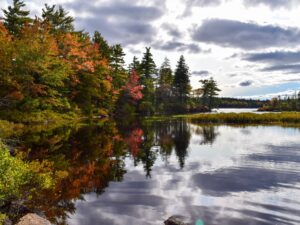To Conserve or Not to Conserve
25 Nov 2020
Have you ever looked at your land and thought, “I wish it could stay like this forever”? Or have you ever feared what will happen to your property when you are no longer there? A conservation easement permanently protects your property’s ecological features, while allowing you to retain ownership and enjoyment of your land for you and future generations to enjoy.
What is a conservation easement?

Photo Credit: Stephen Glazier
A conservation easement is a written agreement between a landowner and an authorized ‘easement holder”, created to protect the property’s conservation value by restricting some land uses and types of development that can then happen on the property. The landowner still retains ownership of the land, and they can sell, donate, or pass the land on to the next generation. The restrictions, however, run with the deed, so apply in perpetuity, no matter who owns the land.
Across Canada, these sorts of agreements are known as conservation easements, conservation covenants, or servitudes. Conservation easements create a structured and legally enforceable relationship between the owner of the land and the Land Trust. Each relationship is unique and should reflect the particular circumstances of the owner, the land, and the Land Trust.
Any landowner can enter into a conservation easement with any organization that the Conservation Easements Act allows, which often is a land trust or government body. In Nova Scotia, specific conservation organizations, such as the Nova Scotia Nature Trust, are designated under the legislation as eligible to hold a conservation easement.
Pros vs. Cons
Conservation easements are made for the purpose of protecting, restoring, or enhancing land that contains rare pieces, important habitats, natural ecosystems, landforms, or landscapes that the owner and the easement holder would like to protect in perpetuity. It does restrict activities that could harm the land’s natural values, so only makes sense for landowners who are certain about their vision for the land, now and into the future.
For those who do want to protect their land, an easement is an excellent conservation tool. It is not uncommon for landowners to confide that while they have a deep connection with the property, they are unsure whether or not the next generation will continue to have this relationship and they worry about what might happen to the land beyond their lifetime. Through a conservation easement, the land trust is a trusted partner, becoming the steward of the property and ensuring the landowner’s wishes for the land are met, forever. The Nature Trust will continue to monitor and enforce the terms of the agreement in perpetuity.
Besides the environmental benefits and the incredible opportunity to leave a natural legacy for generations to come, which are reason enough to conserve your land, there may also be potential tax incentives. When a person donates an easement, they are giving away an interest in their land. Conservation easements entitle the landowner to a charitable donation receipt equal to the reduction in market value. As well, the area of the land protected may be exempt from property taxes. There may be special tax incentives available for landowners who place a conservation easement on their property through Environment and Climate Change Canada’s (ECCC) Ecological Gifts Program, including capital gains tax benefits and increased income tax incentives.
How?
Now that you know what a conservation easement is, you may be wondering how this all works? It is important to remember that when entering into a conservation easement, the landowner remains the owner of the land. The owner gives the Land Trust (Nature Trust) the right to access the property for purposes of monitoring, enforcement, and restoration of damage. The landowner retains all rights of ownership except for those that are specifically restricted in the easement or inconsistent with the purpose of the easement. The land transfer can occur at any time, meaning the owner can sell, rent or lease the land, or pass it on to whomever they wish.
The holder of the easement (the Nature Trust) assumes permanent responsibility for ensuring that all future owners abide by the terms set out in the agreement. The Nature Trust will discuss the owner’s wishes, answer their questions, and—if the easement is not being respected—will act to correct the violation and protect the ecological integrity of the land, including potential legal action if required.
It is always recommended that a landowner seek independent legal, tax, and financial advice to determine whether a conservation easement or other land conservation option is best suited to their particular circumstances.
Great Examples!
In 2007, the Nature Trust signed the first-ever conservation easement agreement between a land trust and a municipality in Canada when we finalized the Wolfville Watershed Nature Preserve with the Town of Wolfville. We are also currently negotiating a conservation easement with another Nova Scotia municipality. These examples are situations where the municipality is committing to working with us to manage the property for conservation while, at the same time, retaining ownership and public benefit.
In addition to holding conservation easements with individuals and municipalities, we also hold conservation easements with Acadia University with Bon Portage Island (2012) and Partridge Island (2016), and many individual landowners and families across the province.
To Conserve or Not to Conserve
It’s not very often that you have an opportunity to make real change and leave your mark on the world for future generations to come, but a conservation easement can do just that!
If a conservation easement doesn’t sound like the right fit, don’t worry! Go to the Nature Trust’s booklet, Conservation Options for Landowners, and see if any of our other conservation options might work for you and your land.
